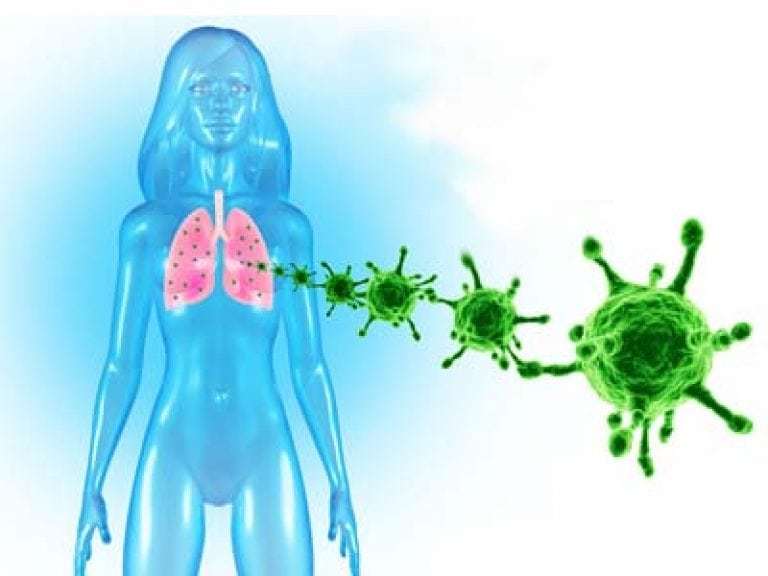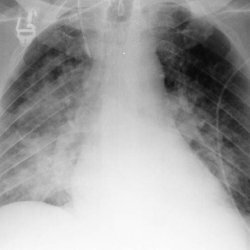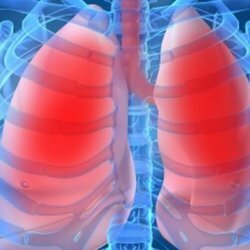Sarcoidosis of the lungs, what is it, why does it occur and how does it manifest?
Sarcoidosis is an inflammatory disease in which multiple nodules (granulomas) form in the tissues of the body. The lungs and lymph nodes of the mediastinum are mainly affected, less often other organs. Due to the variety of clinical manifestations, it is not always possible to make a diagnosis immediately.
Sarcoidosis (Benier-Beck-Schaumann disease) is a multiple organ pathology with a predominant lesion of the lungs and intrathoracic lymph nodes. The disease develops in predisposed individuals under the influence of a wide range of provoking factors. It is based on granulomatous inflammation with the formation of nodules in the tissues - epithelioid cell granulomas.
Content
- Prevalence of the disease
- Causes and mechanisms of development
- Hereditary theory
- Infectious theory
- The role of environmental factors
- Role of medicines
- Clinical manifestations
- Lung damage
- The most common extrapulmonary manifestations of the disease
- Peripheral lymph node involvement
- Skin lesions
- Eye damage
- Heart failure
- Diagnostics
- Clinical data
- Laboratory data
- Instrumental examination methods
- Classification
- Treatment
- Forecast
Prevalence of the disease
Sarcoidosis of the lungs occurs at any age. Men and women from 20 to 35 years old get sick equally often, after 40 years, the disease affects mainly women.
Cases of sarcoidosis are widely reported, but the geographic prevalence varies:
- European countries 40 per 100 thous. population;
- New Zealand 90 per 100 thousand;
- Japan is only 0.3 per 100 thousand;
- Russia 47 per 100 thous.
Sarcoidosis is a rather rare disease, so people who have it, as a rule, do not know what it is.
Causes and mechanisms of development
The exact causes of the disease have not been finally established, therefore, the etiology and mechanisms of development of sarcoidosis are the subject of research by scientists around the world.

Hereditary theory
Familial cases of sarcoidosis have been reported. It describes its simultaneous development in two sisters living in different cities. The connection of the disease and variants of its course with the carriage of certain genes was revealed.
Infectious theory
It was previously believed that sarcoidosis is caused by Mycobacterium tuberculosis. This theory was supported by the facts of the development of the disease in persons who had previously suffered from tuberculosis. The patients were tried to be treated with Isoniazid (an anti-tuberculosis drug), which did not give the expected effect. However, when examining the material of the lymph nodes of patients with sarcoidosis, the causative agents of tuberculosis were not found.
The following were considered as possible causative agents of sarcoidosis:
- Helicobacter pylori;
- hepatitis C virus;
- herpes simplex virus;
- Borrelia;
- Chlamydia pneumoniae.
High titers of antibodies to these infectious agents were found in the blood serum of the patients. According to modern concepts, pathogenic microorganisms act as provoking factors in the development of pathology.
The role of environmental factors

Air pollution leads to the development of respiratory diseases. Among people who regularly come into contact with different types of dust, sarcoidosis is 4 times more common.
- miners (coal);
- grinders (metal particles);
- firefighters (smoke, soot);
- workers of libraries, archives (book dust).
Role of medicines
There is a connection between the development of granulomatous inflammation and the intake of medications that affect the immune system:
- Interferon alpha;
- Antineoplastic agents;
- Hyaluronic acid.
The disease often develops spontaneously, and the probable cause cannot be established.
Under the influence of provoking factors (antigens), a special type of immune response is formed in predisposed people. Lymphocytic alveolitis, granulomas, vasculitis develop. For the later stages of the disease, the presence of pulmonary fibrosis is characteristic - the replacement of the affected areas with connective tissue.
Clinical manifestations

A feature of the disease is the absence of specific signs that would clearly indicate it. Sarcoidosis can be asymptomatic for a long time, it can be detected by chance when you see a doctor for another reason. Sometimes it disguises itself as other diseases, therefore, on an outpatient basis, the number of erroneous diagnoses in these patients reaches 30%. In the advanced stage of the disease, the symptoms of lung damage are combined with general manifestations and signs of involvement of other organs.
Read also:Fluid in the lungs
Common signs:
- Fatigue, weakness, decreased performance.
- Aching joint pains. They are not accompanied by swelling, redness, limitation of mobility, and do not lead to the development of deformities. Not to be confused with acute arthritis, which sometimes occurs at the onset of the disease!
- Fever is an increase in body temperature to subfebrile values.
- Muscle pain that occurs due to intoxication or the development of granulomas.
The severity of common manifestations varies from patient to patient.
Lung damage
Sarcoidosis of the lungs and intrathoracic lymph nodes occurs in 90-95% of patients. It is advisable to consider their manifestations together because of the anatomical proximity of structures and a single mechanism for the development of changes. In the lung tissue, alveolitis first occurs, then granulomas, with a prolonged course of the disease, fibrosis. The morphological substrate of lymphadenitis is granulomatous inflammation.
Complaints:
- Cough - initially dry, harsh, reflexive. It is associated with compression of the bronchi by enlarged lymph nodes and irritation of the nerve endings. The appearance of sputum indicates the addition of a bacterial infection.
- Chest pains - associated with damage to the pleura, occur with deep breathing, coughing, are very intense.
- Shortness of breath - in the initial stages of the disease is associated with the development of alveolitis and impaired bronchial patency due to an increase in lymph nodes. Later, with the development of pronounced fibrotic changes in the lungs, shortness of breath becomes constant. She points to development pulmonary hypertension and respiratory failure.
With alveolitis, the doctor uses auscultation to determine the zones of crepitus. With small areas of damage, they may not be there. A sign of the development of fibrosis is a weakening of vesicular breathing, deformation of the bronchi - dry wheezing.
The most common extrapulmonary manifestations of the disease

Peripheral lymph node involvement
Peripheral lymph nodes change after the development of hilar lymphadenopathy and lung damage.
The following groups of lymph nodes are affected:
- cervical;
- inguinal;
- supraclavicular;
- axillary.
They are enlarged, firm to the touch, mobile and painless.
Skin lesions
Cutaneous manifestations occur in 50% of patients with pulmonary sarcoidosis.
- Erythema nodosum is the body's response to disease. Painful, dense, rounded formations of red color appear on the skin of the hands and feet. This is a marker of the onset of the disease and an indicator of the activity of the process.
- Sarcoid plaques are symmetrical rounded formations with a diameter of 2-5 mm, purple-cyanotic color with a white spot in the center.
- The phenomenon of "revived" scars - soreness, induration, redness of old postoperative scars.
- Chilled lupus - a consequence of chronic granulomatous inflammation of the skin. It becomes uneven, bumpy due to small nodules, peels off.
Eye damage
Most often, uveitis (inflammation of the choroid) is detected. If it develops at the onset of the disease, then it flows benignly, disappears even without treatment. Symptoms of uveitis against the background of long-standing lung damage indicate a worsening prognosis. Patients complain of dryness and pain in the eyes.
Heart failure
Heart disease develops in 25% of patients with sarcoidosis and leads to poor outcomes of the disease:
- Myocarditis - granulomatous inflammation of the heart muscle.
- Dry or exudative pericarditis.
- Heart failure.
Sarcoidosis affects the kidneys, spleen, digestive organs, musculoskeletal system, central and peripheral nervous system. The detection rate of clinically significant conditions is no more than 5-10%.
Read also:Signs of pneumonia in an adult without fever: is it possible?
Diagnostics

Given the variety of manifestations and the absence of specific symptoms of the disease, its timely detection presents significant difficulties. The diagnosis is made on the basis of clinical data, the results of laboratory and instrumental examination of the patient.
Clinical data
Signs of possible sarcoidosis:
- prolonged dry coughnot associated with a respiratory viral infection, disturbing regardless of the season;
- erythema nodosum - 60% of all its cases are associated with sarcoidosis;
- unexplained weakness;
- subfebrile condition;
- symptoms of combined organ damage;
- burdened family history - sarcoidosis in close relatives;
With such clinical data, the patient needs additional examination.
Laboratory data
Non-specific studies:
- Complete blood count - increase ESR and the number of leukocytes; in 25-50% of patients the level of eosinophils increases and monocytes, a decrease in the number of lymphocytes.
- Biochemical blood test - an increase in acute phase indicators: CRB, sialic acids, seromucoid.
The test results will indicate an inflammatory process in the body.
Studies that are prescribed when the likelihood of the disease is high:
- Determination of ACE level - increase. A blood test is taken in the morning on an empty stomach.
- Determination of calcium content in urine and blood serum - increase.
- Determination of the level of tumor necrosis factor alpha is an increase, with active sarcoidosis it is secreted by alveolar macrophages.
- The study of fluid obtained with bronchoalveolar lavage (BAL) - a high level of lymphocytes and phospholipids indicates lymphocytic alveolitis.
- Mantoux reaction or Diaskin test - to exclude a tuberculous process.
Instrumental examination methods
- Chest X-ray is an affordable method that allows you to identify an increase in mediastinal lymph nodes, pulmonary infiltration, and establish the stage of the disease. Sarcoidosis is characterized by bilateral localization of changes.
- X-ray computed tomography (CT) - the method allows you to obtain layer-by-layer images, to identify changes at an early stage. A typical sign of alveolitis is a "frosted glass" symptom. The tomogram shows granulomas 1-2 mm in size. If sarcoidosis is suspected, it is preferable to refer patients to CT scan instead of X-ray.
- Spirometry - a method for diagnosing the function of external respiration. Allows you to exclude bronchial asthma and chronic obstructive pulmonary disease. In pulmonary sarcoidosis, the vital capacity of the lungs decreases with a normal or slightly reduced FEV 1 (forced expiratory volume per second). Compression of the bronchi at an early stage of the disease leads to a decrease in MOC (instantaneous volumetric velocity).
- Bronchoscopy - a method of examining the bronchi using an endoscope, is especially important in verifying the diagnosis. During bronchoscopy, BAL fluid is performed, the resulting fluid is sent for research.
- Biopsy - performed transbronially (with bronchoscopy), transthoracally (through the chest wall) or from altered peripheral lymph nodes. In sarcoidosis, granuloma consists of epithelial and giant cells, does not contain areas of necrosis.
Classification
Difficulties in creating a unified classification are associated with a variety of clinical signs, the lack of generally accepted criteria for the activity and severity of the disease. Several options for classifying sarcoidosis have been proposed.
By the type of process flow:
- Acute - a sudden onset of the disease, high activity, a tendency to spontaneous remission.
- Chronic - asymptomatic onset, long-term course of the disease, low activity.
The most common variant of the acute course of sarcoidosis is Löfgren's syndrome: erythema nodosum, fever, arthritis, and enlargement of the intrathoracic lymph nodes.
By the nature of the flow:
- Stable - no dynamics of the state.
- Progressive - deterioration of the patient's condition.
- Regressive - resolution of existing changes, improvement of the patient's condition.
Read also:Shortness of breath - its types, causes, symptoms and treatment features of rapid and shortness of breath
For radiological changes:
| stage | changes | % of patients |
| Absence of changes in the lungs and lymph nodes of the mediastinum | 5 | |
| I | Enlargement of intrathoracic lymph nodes in the absence of changes in the lungs | 50 |
| II | Combination of lymphadenopathy with pulmonary infiltration | 30 |
| III | Changes in lung tissue with normal sizes of mediastinal lymph nodes | 15 |
| IV | Signs of common pulmonary fibrosis | 20 |
By the degree of activity:
0 - there are no symptoms of the disease and laboratory signs of inflammation;
1 - there are symptoms of the disease and signs of inflammation, according to analyzes;
Treatment

Patients are treated and monitored by TB doctors at TB dispensaries. In the future, it is planned to open specialized centers. In other countries, family doctors are involved in the treatment of sarcoidosis, and if necessary, patients are hospitalized in multidisciplinary hospitals.
If X-ray changes are detected without signs of clinical and laboratory activity, drug treatment is not indicated, the patient is registered, monitored over time.
Groups of drugs:
- Glucocorticosteroids are the treatment of choice for sarcoidosis. They are prescribed internally with a progressive course of the disease, the presence of complaints. The duration of therapy is from six months to 2 years.
- Methotrexate - a drug from the group of cytostatics, is prescribed to patients with generalized forms of the disease. Methotrexate reduces the formation of granulomas.
- Infliximab - the drug contains antibodies to TNF. It has not yet received widespread use due to its high cost, but studies have shown good results in the treatment of sarcoidosis.
- Pentoxifylline is a drug to improve microcirculation, it is prescribed in tablets for a long time. In treatment, it is of secondary importance.
- Alpha-tocopherol, an antioxidant, is prescribed in addition to essential drugs.
Forecast
In patients, there is both a gradual regression of the disease (spontaneous or under the influence of treatment), and its steady progression with the development of respiratory failure.
Assessment of the forecast based on the totality of survey data:
| Favorable prognosis | Bad prognosis | |
| anamnesis | The onset of the disease at a young age, the duration of remission is more than 3 years. | Family history, African American or Scandinavian, onset of illness at an older age, recurrence of illness after a course of hormones, exposure to dust. |
| Clinical data | Löfgren's syndrome or asymptomatic course. | Cough and shortness of breath at the time of detection of the disease; complaints characteristic of the defeat of other organs. |
| Laboratory data | High levels of phospholipids, lymphocytes, tumor necrosis factor in the bronchoalveolar fluid. | High levels of neutrophils and eosinophils in BAL fluid. Hypercalcemia. |
| Radiology | Stage 0-II. | Stage III-IV |
| Bronchoscopy | Without pathology. | Deformation and narrowing of the lumen of the bronchi, infiltration of the mucous membrane, granulomas in the walls of the bronchi. |
| Spirometry indicators | Without pathology. | VC and FEV 1 less than 70% of the due. |
| Extrapulmonary manifestations | Erythema nodosum, anterior uveitis. | Signs of damage to the heart, nervous system, posterior uveitis, lupus fever. |
Mortality in chronic forms of the disease averages 7.5%.
The main causes of death:
- pulmonary heart failure;
- concomitant damage to the heart and nervous system;
- accession of secondary infections against the background of hormonal therapy.
Since the causes of the disease are not fully understood, a set of preventive measures has not been developed. People whose relatives have suffered from sarcoidosis are advised to avoid contact with dust and regularly undergo fluorography. When a disease is detected, one should not neglect visits to a phthisiatrician, even if you feel well. Patients with pulmonary sarcoidosis maintain their ability to work and maintain a satisfactory quality of life. With the development of pronounced changes, they are recognized as disabled groups 2-3.



